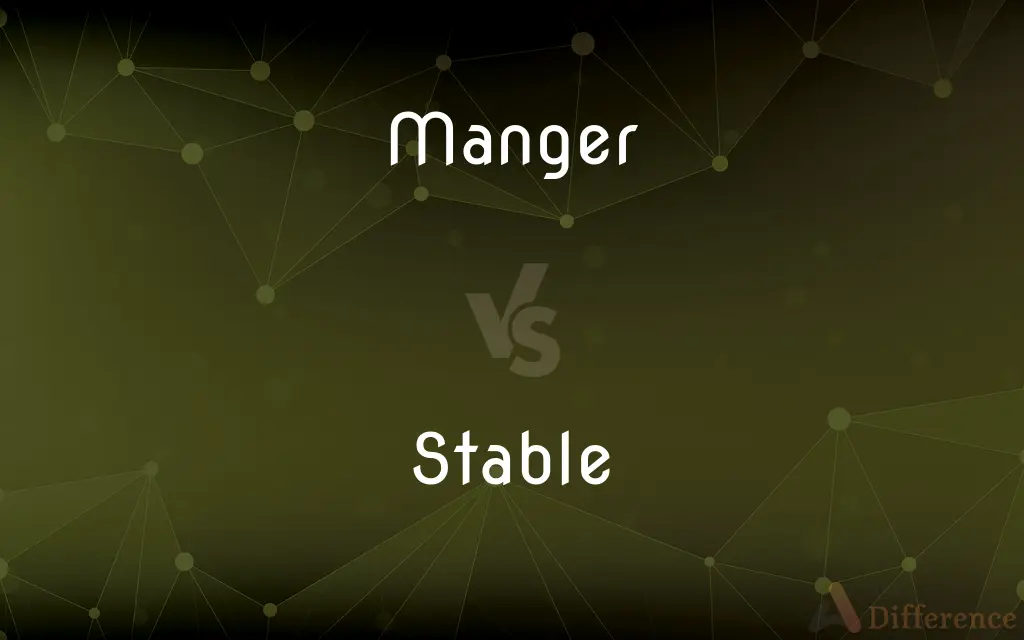Manger vs. Stable — What's the Difference?
By Tayyaba Rehman — Updated on October 14, 2023
A manger is a trough for animals to eat from, while a stable is a building where they're kept or housed.

Difference Between Manger and Stable
Table of Contents
ADVERTISEMENT
Key Differences
Both mangers and stables are often associated with animals, particularly in farming and livestock contexts, but they serve different functions.
A manger is specifically a type of feed trough, typically made of wood or stone, where food for livestock is placed. On the other hand, a stable is a building or structure, usually with multiple stalls, designed to house animals like horses, cattle, and other livestock.
Stables are meant to provide shelter and protection for animals from the elements and potential predators. Inside a stable, one might find mangers where the animals can conveniently eat without leaving their sheltered environment.
While the two are distinct, they can be interconnected. In many stables, especially those designed for horses, mangers are incorporated into the stalls or along the walls to provide animals easy access to their food.
Historically, the terms have been deeply embedded in culture, especially in religious contexts. The Christmas story often mentions a manger, which is said to be where baby Jesus was laid. It's important to note that while the manger is highlighted in this narrative, it's understood that it was located within a stable or similar shelter.
ADVERTISEMENT
Comparison Chart
Function
Feed trough for animals.
Building to house animals.
Material
Typically made of wood or stone.
Made of various materials, including wood, brick, or metal.
Relationship with animals
Where animals eat from.
Where animals live or are sheltered.
Size & Structure
Simple, open container.
Larger, enclosed structure with stalls.
Historical/Cultural Usage
Associated with the birthplace of Jesus in nativity.
Common setting in farming and livestock tales.
Compare with Definitions
Manger
A feed trough for livestock.
The hay was neatly placed in the manger for the cows.
Stable
A building for housing livestock.
The farmer built a new stable for his growing herd of horses.
Manger
A container usually made of wood or stone.
The old manger had weathered many winters but still held up.
Stable
Often contains stalls for individual animals.
Each horse had its own stall within the stable.
Manger
Found within stables for feeding purposes.
Each stall in the stable had its own manger.
Stable
Can be made of various materials.
The brick stable stood for over a century.
Manger
Provides easy access to food for sheltered animals.
The horses leaned over to eat from the manger.
Stable
A stable is a building in which livestock, especially horses, are kept. It most commonly means a building that is divided into separate stalls for individual animals and livestock.
Manger
Associated with nativity scenes.
The figurine of baby Jesus was placed in the manger.
Stable
(of an object or structure) not likely to give way or overturn; firmly fixed
Specially designed dinghies that are very stable
Manger
A manger or trough is a rack for fodder, or a structure or feeder used to hold food for animals. The word comes from the Old French mangier (meaning "to eat"), from Latin mandere (meaning "to chew").Mangers are mostly used in livestock raising and generally found at stables and farmhouses.
Stable
A building set apart and adapted for keeping horses
The horse was led from its stable
Manger
A long trough from which horses or cattle feed.
Stable
Put or keep (a horse) in a stable
They must be stabled and fed
Manger
A trough or an open box in which feed for livestock is placed.
Stable
Resistant to change of position or condition; not easily moved or disturbed
A house built on stable ground.
A stable platform.
Manger
A trough for animals to eat from.
Stable
Not subject to sudden or extreme change or fluctuation
A stable economy.
A stable currency.
Manger
A trough or open box in which fodder is placed for horses or cattle to eat.
And she brought forth her firstborn son, and wrapped him in swaddling clothes, and laid him in a manger; because there was no room for them in the inn.
Stable
Maintaining equilibrium; self-restoring
A stable aircraft.
Manger
The fore part of the deck, having a bulkhead athwart ships high enough to prevent water which enters the hawse holes from running over it.
Stable
Enduring or permanent
A stable peace.
Manger
A container (usually in a barn or stable) from which cattle or horses feed
Stable
Consistent or dependable
She has been stable in her support for the project.
Stable
Not showing or marked by erratic or volatile emotions or behavior
He remained stable even after he lost his job.
Stable
(Physics) Having no known mode of decay; indefinitely long-lived. Used of atomic particles.
Stable
(Chemistry) Not easily decomposed or otherwise modified chemically.
Stable
A building for the shelter and feeding of certain domestic animals, especially horses.
Stable
A group of animals lodged in such a building.
Stable
All the racehorses belonging to a single owner or racing establishment.
Stable
The personnel employed to keep and train such a group of racehorses.
Stable
A group, as of athletes or entertainers, under common management
A stable of prizefighters.
Stable
To put or keep in a stable.
Stable
To live in a stable.
Stable
A building, wing or dependency set apart and adapted for lodging and feeding (and training) ungulates, especially horses.
There were stalls for fourteen horses in the squire's stables.
Stable
(metonymy) All the racehorses of a particular stable, i.e. belonging to a given owner.
Stable
(Scotland) A set of advocates; a barristers' chambers.
Stable
(sumo) An organization of sumo wrestlers who live and train together.
Stable
(professional wrestling) A group of wrestlers who support each other within a wrestling storyline.
Stable
A group of prostitutes managed by one pimp.
Stable
A group of people who are looked after, mentored, or trained in one place or for a particular purpose or profession.
Stable
(transitive) to put or keep (an animal) in a stable.
Stable
(intransitive) to dwell in a stable.
Stable
To park (a rail vehicle).
Stable
Relatively unchanging, steady, permanent; firmly fixed or established; consistent; not easily moved, altered, or destroyed.
He was in a stable relationship.
A stable government
Stable
(computing) Of software: established to be relatively free of bugs, as opposed to a beta version.
You should download the 1.9 version of that video editing software: it is the latest stable version. The newer beta version has some bugs.
Stable
That maintains the relative order of items that compare as equal.
Stable
Firmly established; not easily moved, shaken, or overthrown; fixed; as, a stable government.
In this region of chance, . . . where nothing is stable.
Stable
Steady in purpose; constant; firm in resolution; not easily diverted from a purpose; not fickle or wavering; as, a man of stable character.
And to her husband ever meek and stable.
Stable
Durable; not subject to overthrow or change; firm; as, a stable foundation; a stable position.
Stable
So placed as to resist forces tending to cause motion; of such structure as to resist distortion or molecular or chemical disturbance; - said of any body or substance.
Stable
To fix; to establish.
Stable
To put or keep in a stable.
Stable
To dwell or lodge in a stable; to dwell in an inclosed place; to kennel.
Stable
A house, shed, or building, for beasts to lodge and feed in; esp., a building or apartment with stalls, for horses; as, a horse stable; a cow stable.
Stable
A farm building for housing horses or other livestock
Stable
Shelter in a stable;
Stable horses
Stable
Resistant to change of position or condition;
A stable ladder
A stable peace
A stable relationship
Stable prices
Stable
Firm and dependable; subject to little fluctuation;
The economy is stable
Stable
Not taking part readily in chemical change
Stable
Maintaining equilibrium
Stable
Showing little if any change;
A static population
Stable
Provides protection and shelter for animals.
The sheep were safe in the stable during the storm.
Stable
A common setting in farming communities.
The village had a communal stable where residents could keep their cattle.
Common Curiosities
What is a manger used for?
A manger is used as a feed trough for livestock.
What animals are typically found in a stable?
Horses, cattle, and other livestock are commonly housed in stables.
Do stables need regular maintenance?
Yes, to ensure the safety and health of animals, stables require regular cleaning and upkeep.
Is a manger the same as a stable?
No, a manger is a feed trough, while a stable is a building housing animals.
Are stables used for purposes other than housing animals?
While primarily for animals, some stables are repurposed for storage or other uses.
Can mangers be made of materials other than wood or stone?
Yes, mangers can also be made of metal or plastic, especially modern ones.
Are all stables large and spacious?
Stables vary in size; some are large with many stalls, while others are smaller.
Why are mangers important in livestock care?
Mangers provide a designated place for feeding, ensuring animals get their nutrition.
Can a stable exist without a manger?
Yes, a stable can exist without a manger, but it's common to have them for feeding.
Why is a manger associated with the Christmas story?
The manger is associated with the Christmas story because it's said baby Jesus was laid in one.
What is the significance of a manger in a nativity scene?
In nativity scenes, the manger represents the humble birthplace of Jesus.
Are mangers only found in stables?
Mangers are commonly found in stables, but they can also be found in pastures or barns.
Can a manger be placed outside of a stable?
Yes, mangers can be placed in open pastures or other areas for feeding.
Is it necessary for a stable to have individual stalls?
Not always. Some stables have open designs without specific stalls.
Share Your Discovery

Previous Comparison
Throne vs. Thrown
Next Comparison
Prejudice vs. BigotryAuthor Spotlight
Written by
Tayyaba RehmanTayyaba Rehman is a distinguished writer, currently serving as a primary contributor to askdifference.com. As a researcher in semantics and etymology, Tayyaba's passion for the complexity of languages and their distinctions has found a perfect home on the platform. Tayyaba delves into the intricacies of language, distinguishing between commonly confused words and phrases, thereby providing clarity for readers worldwide.














































